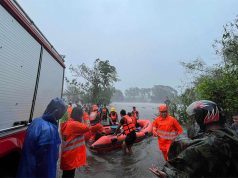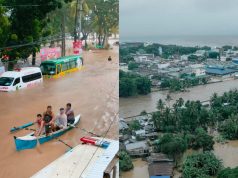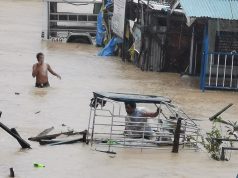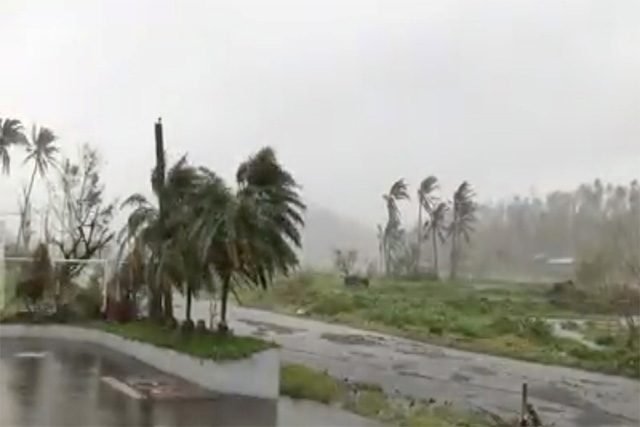
The National Disaster Risk Reduction Management Council found itself on the trending list of local Twitter Wednesday morning as the agency issued emergency alerts about possible storm surges through text messages in light of Typhoon Ulysses (International name: Vamco).
Some Filipinos claimed of waking up due to the notification sounds of the text alerts, which are usually accompanied by a warning sound. The alarming tone wouldn’t go off unless the receiver has read the message.
Others found the text alerts annoying or anxiety-inducing, especially during sleeping hours, but their fellow Filipinos reminded them that the warnings were designed to make them prepare for the potential impacts of the severe weather disturbance.
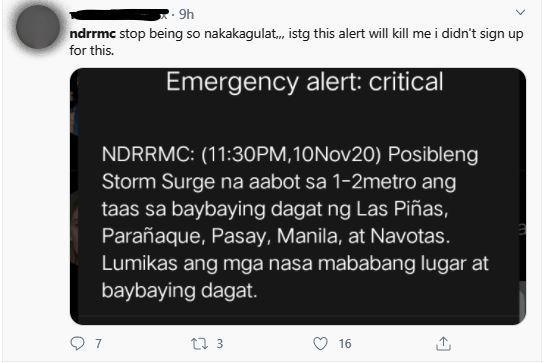


“(Anyway), people (are) getting annoyed with NDRRMC alerts, I mean I know its annoying and nakakagulat ‘yung tone, but don’t (you) think it’s better to be alert than sorry. Also, at least some of the public funds are being put to good use during times like this,” a Twitter user said in response to posts of Filipinos complaining about the alert.
“Just please stop complaining about getting the NDRRMC alerts. Just appreciate the effort NDRRMC is doing. Because we didn’t have that when Ondoy and Yolanda happened,” she added, referencing the two strong tropical cyclones that happened in 2009 and 2013, respectively.
“Woke up to (people) complaining that the texts NDRRMC are sending them scare them… Buti nga kayo nakatanggap kayo ng warning galing sa government eh. Have y’all forgotten? 2013? Almost 72k people died (because) of the damned storm surge (because) no one warned them since even PAGASA themselves did not expect it,” another Filipino tweeted.
In September 2009, Typhoon Ondoy battered Metro Manila and parts of Central Luzon as it brought a “month’s worth of rainfall in just 12 hours.” It reportedly displaced more than 450,000 people while at least 140 individuals lost their lives.
Four years after, Super Typhoon Yolanda, considered one of the most powerful typhoons of all time, swept across Southern Luzon, Visayas and Mindanao and displaced more than 4.1 million people. It also took the lives of more than 6,000 individuals.
Meanwhile, another Twitter user reminded Filipinos that they could turn off the notification for emergency alerts in the settings of their mobile phones if they don’t want to be bothered by NDRRMC’s warning tone.
dude i dont get it why people are mad at NDRRMC when you can just turn it off,,,,,,,,,,, 💀
i cant stress enough how important these alerts right now just turn it off if alerts distrubs and scares you tf. pic.twitter.com/rtqGc3qX8G
— FYS 🧡 | ZOMBIE – SOTY (@jaetineme) November 10, 2020
NDRRMC on Tuesday and Wednesday morning sent text alerts to warn residents of affected areas of a possible storm surge due to the effects of “Ulysses,” which has intensified to typhoon category as of 8 a.m. Wednesday.
It is the 21st tropical cyclone to have entered the Philippine Area of Responsibility this year.
Storm surge, also known as “daluyong ng bagyo,” pertains to the abnormal rise in sea level that occurs during tropical cyclones as caused by strong winds and low atmospheric pressure.
Low-lying coastal areas and other places near rivers or other tributaries are cautioned of potential flooding.
Thank you NDRRMC! Hindi ko narinig. Pero scary… sa Metro Manila na Storm Surge. Is this really a goodbye for Dolomite if tatama sa Manila? pic.twitter.com/CpDQ5ifEC2
— Karissa 🎀 (@_kariiissa) November 10, 2020
As of Wednesday morning, some Filipinos have also claimed to receive alerts informing them of being placed under Tropical Cyclone Wind Signal No. 3 due to the typhoon.
woke up because of NDRRMC's alerts. thankful for these alerts. Stay safe and dry friends. 🙏🏽 pic.twitter.com/Hug3PQpuW3
— ♡ ⁷ (@Lorinrinrin) November 11, 2020
Several areas of Luzon, including Metro Manila, have already been placed under Signal No. 3 prior to “Ulysses'” landfall on Wednesday evening in the Quezon Province.
Reports note that it is forecast to pass over the seas north of Catanduanes between Wednesday morning and afternoon and north of Camarines provinces between Wednesday afternoon and evening.
These areas may fall within the inner rainbands or eyewall of Ulysses during its passage.
The typhoon is also projected to make landfalls over Polillo Islands and mainland Quezon between Wednesday evening and early Thursday morning. Ulysses may attain its peak intensity of 130 to 155 kilometers per hour ahead of landfall.
It will then cross Central Luzon and emerge over the western seaboard of Zambales between Thursday morning and afternoon.
RELATED: LIVE updates: Severe Tropical Storm Ulysses
Text alerts are mandated by law
NDRRMC, the country’s agency under the Department of National Defense’s Office of Civil Defense, is mandated to send text message alerts at regular intervals in times of disasters by the Free Mobile Disaster Alerts Act.
The law, also known as Republic Act 10639, was signed by former president Benigno Aquino III in 2014, a year after Super Typhoon Yolanda wrecked parts of the country.
RELATED: Has NDRRMC texted you about rains lately? Here’s the important reason why
It states that the NDRRMC, with the help of the National Telecommunications Commission and private mobile phone service providers, are supposed to inform people of natural disasters and calamities through text messages.
The alerts are supposed “to prevent injuries, destruction and loss of lives and property.”
Other relevant government agencies mandated to send alerts are the Philippine Atmospheric Geophysical and Astronomical Services Administration and the Philippine Institute of Volcanology and Seismology, among others.
The law said that people located near and within the affected areas are supposed to receive alerts.
“The alerts shall include contact information of local government units and other agencies required to respond to the situation. The alerts may contain other relevant information such as, but not limited to, evacuation areas, relief sites and pick-up points,” it added.
The law was enacted after the disaster of “Yolanda,” when people had used social media as a means to locate their loved ones.





